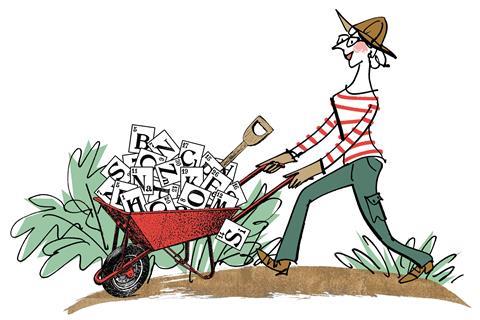With the help of a handful elements from the periodic table, of course

I have always been a gardener, being initiated into the symbiotic world of earthworms and shasta daisies by my mother when I was about five years old. She began at an early age as well, growing up in the family farm where they planted rice, corn, tropical fruit trees and vegetables in southern Philippines, in a small town by the sea. My mother taught me a lot about gardening, such as how to propagate African violets by rooting leaf cuttings in water and how to prepare a foliar fertiliser solution for her orchids. But more importantly, without even knowing it, she introduced me to the periodic table of elements – 21 of them, anyway.
The first two elements every gardener knows about are hydrogen and oxygen. I have a rocky relationship with the power couple H2O. It has the ability to make my limp and under-hydrated Fittonia spring back to life but it also has the ability to bring a slow and dreadful death by root rot, especially prevalent during the winter months.
Then there’s carbon who comes along and befriends oxygen to form the dynamic duo CO2. Carbon dioxide is the yang to our oxygen’s yin, and together with water plays a vital role in photosynthesis, producing glucose for energy with the help of sunlight. Photosynthesis occurs in the leaves and to make sure chlorophyll is able to do its job of absorbing light efficiently, gardeners (indoor gardeners in particular) are urged to eliminate accumulated dust from leaf surfaces. The byproduct of this chemical reaction is precious O2 – that’s just one of the reasons why gardening is beneficial for everyone.
Plants need nutrients, just like we do, so the macronutrient trio NPK – nitrogen, phosphorus and potassium – are a gardener’s allies. Whether from organic sources such as manure and compost, or from commercial fertilisers available in the form of salts, all three contribute to general plant health. The power lies in varying the ratios. You can either encourage leaf growth by choosing a higher nitrogen content or stimulate root growth and flower and fruit production by choosing a higher phosphorus content. Potassium also promotes root growth and fruit production but in addition helps plants resist disease and is involved in photosynthesis.
The next three elements that should be included in a gardener’s list of contacts are calcium, magnesium and sulfur, secondary nutrients that are also essential for plant growth. When it comes to calcium, I’ve found that too much or too little can both be bad things. For instance, calcium build-up in my acid-loving Hydrangea may lead to yellowing leaves, while calcium deficiency in my Peperomia plants is probably the reason behind the leaf curling I sometimes encounter. Magnificent magnesium takes centre stage in chlorophyll and enables it to absorb the red wavelength of the electromagnetic spectrum that it prefers, in the process reflecting the beautiful green colour that gardeners love. Sulfur is present in cysteine and methionine, two of the amino acid building blocks of proteins. It also gives garlic, mustard and onions their characteristic odours.
The effects of the micronutrients gang of nine – boron, chlorine, cobalt, copper, iron, manganese, molybdenum, nickel and zinc – are less publicised. Boron helps cells to grow and is important for the structural stability of cell walls; insufficient levels manifest in stunted and distorted new leaves. Chlorine has always had a bad reputation with gardeners. Using water straight from the tap causes outrage, especially from my orchids and my temperamental and finicky Calathea. There is typically too much chlorine in tap water and its accumulation in the leaves leads to scorching. However, chlorine is beneficial to plants in small quantities and is necessary for water regulation and photosynthesis. Cobalt, copper, iron, manganese, molybdenum and zinc’s involvement in plant growth and development is mainly with enzymes and metabolism. Furthermore, manganese and copper are vital to photosynthesis: manganese catalyses the photolysis of water while copper is an essential component of the protein plastocyanin, present in chlorophyll-containing chloroplasts.
In addition, there’s aluminium, the concentration of which (in the form of Al3+) determines whether the colour of my cherished Hydrangea macrophylla is pink, blue or varying shades in between. And while not essential, silicon helps plants that are under environmental stress and sodium, at low levels, improves the flavour of crops and provides herbivores a source of this essential electrolyte.
No matter what kind of gardener you are, whether you are like my mother who not only has green fingers but green thumbs, green hands and green arms because you can grow anything, or you are like my sister who is an annihilator of all verdurous things, let’s celebrate the 21 elements that plants rely on. And as chemists, let’s find comfort in the fact that the periodic table will always be by our side, keeping us company while we tend to our gardens.












No comments yet